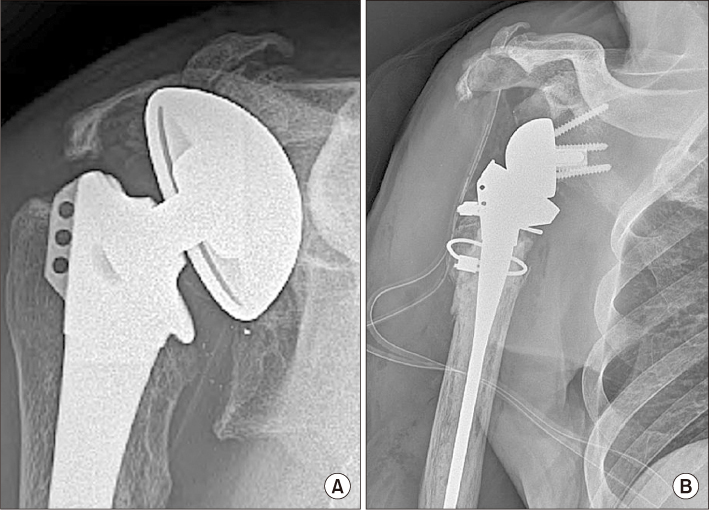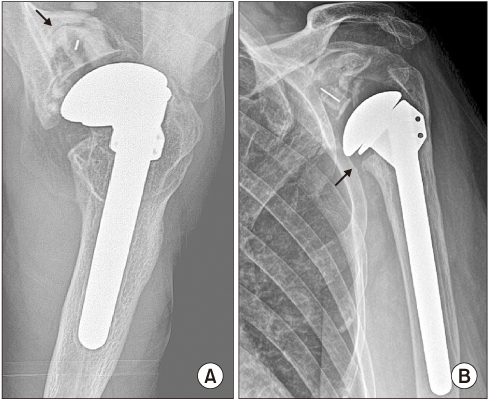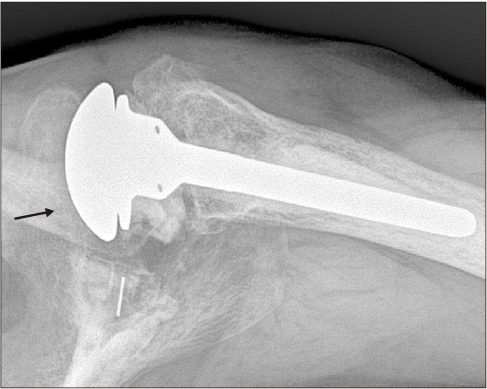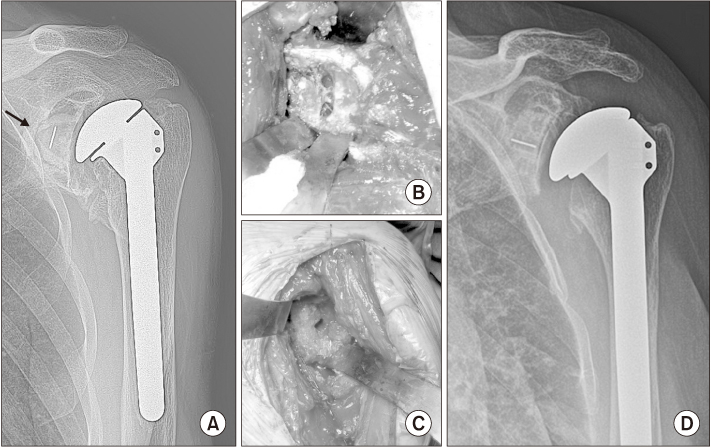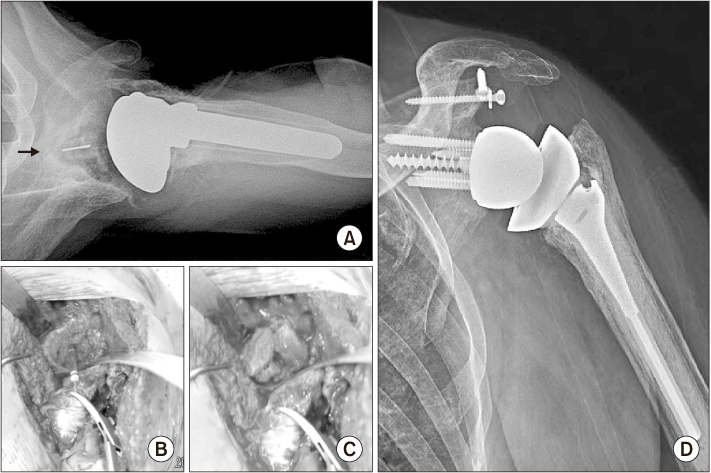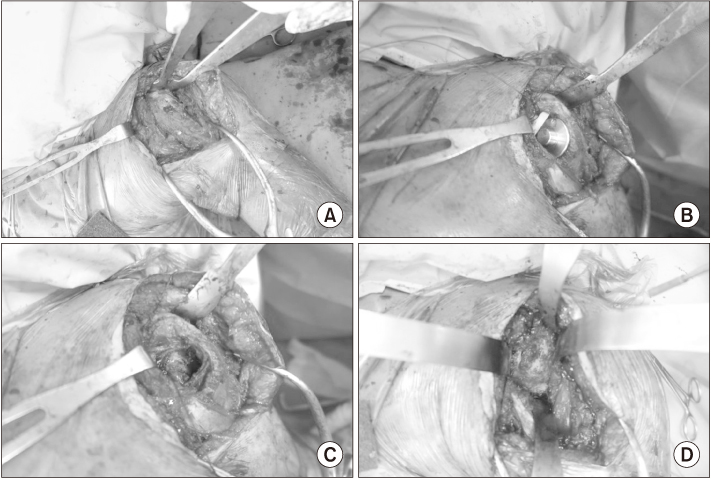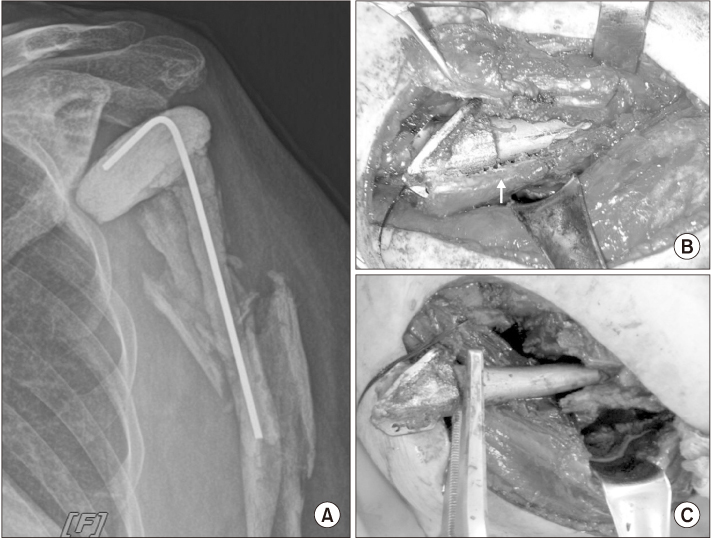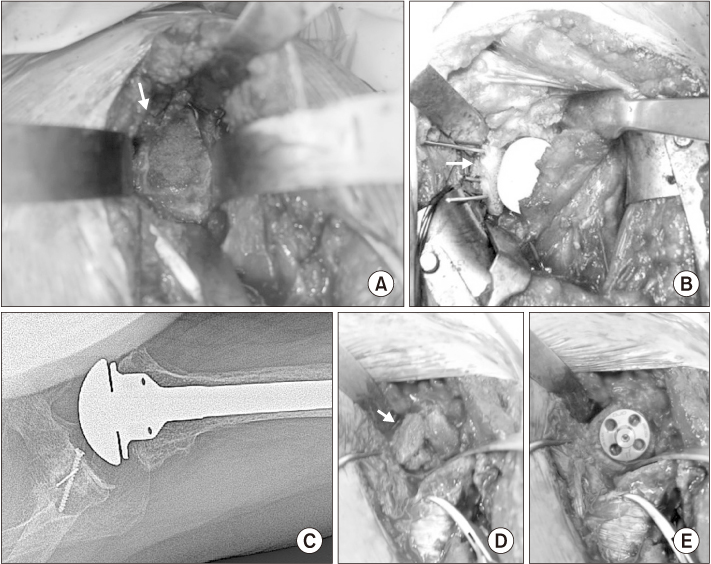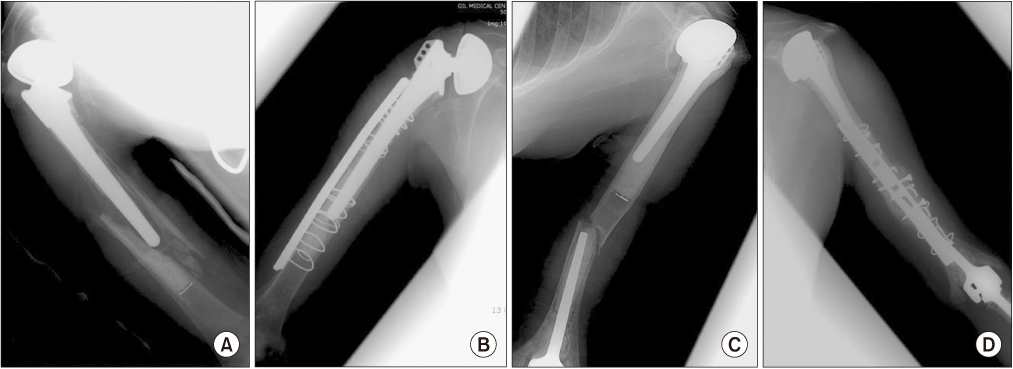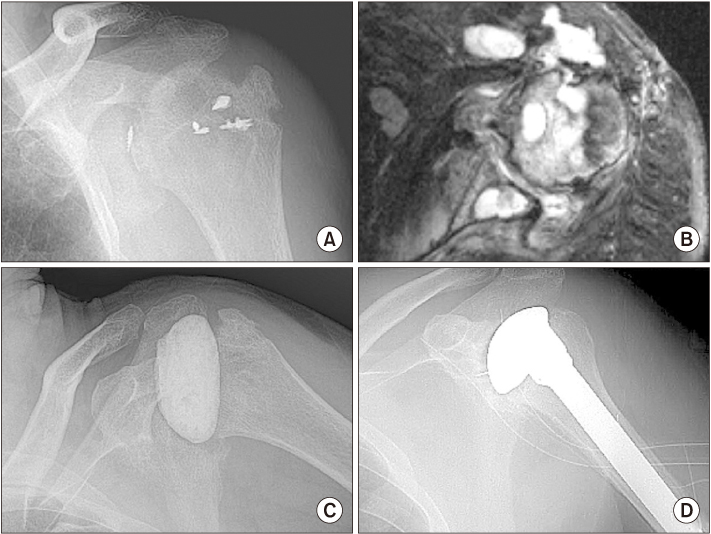J Korean Orthop Assoc.
2019 Apr;54(2):100-109. 10.4055/jkoa.2019.54.2.100.
Etiology and Treatment of Revision Shoulder Arthroplasty
- Affiliations
-
- 1Department of Orthopaedic Surgery, Gil Medical Center, Gachon University College of Medicine, Incheon, Korea. kykhyr@gilhospital.com
- KMID: 2444774
- DOI: http://doi.org/10.4055/jkoa.2019.54.2.100
Abstract
- The rapidly increasing rate of shoulder arthroplasty is certain to increase the number of revision arthroplasties because of parallel increases in complication numbers. It has been widely reported that the causes of revision shoulder arthroplasty include rotator cuff deficiency, instability, glenoid or humeral component loosening, implant failure, periprosthetic fracture, and infection. Revision arthroplasty can be technically challenging, and surgical options available for failed shoulder arthroplasty are limited, especially in patients with glenoid bone loss or an irreparable rotator cuff tear. Furthermore, the outcomes of revision arthroplasty are consistently inferior to those of primary arthroplasty. Accordingly, surgical decision making requires a good understanding of the etiology of failure. Here, we provide a review of indications of revision arthroplasty and of the surgical techniques used by failure etiology.
MeSH Terms
Figure
Reference
-
1. Cofield RH, Edgerton BC. Total shoulder arthroplasty: complications and revision surgery. Instr Course Lect. 1990; 39:449–462.2. Bitzer A, Rojas J, Patten IS, Joseph J, McFarland EG. Incidence and risk factors for aseptic baseplate loosening of reverse total shoulder arthroplasty. J Shoulder Elbow Surg. 2018; 27:2145–2152.
Article3. Boileau P, Melis B, Duperron D, Moineau G, Rumian AP, Han Y. Revision surgery of reverse shoulder arthroplasty. J Shoulder Elbow Surg. 2013; 22:1359–1370.
Article4. Wirth MA, Rockwood CA Jr. Complications of total shoulder-replacement arthroplasty. J Bone Joint Surg Am. 1996; 78:603–616.5. Levine WN, Djurasovic M, Glasson JM, Pollock RG, Flatow EL, Bigliani LU. Hemiarthroplasty for glenohumeral osteoarthritis: results correlated to degree of glenoid wear. J Shoulder Elbow Surg. 1997; 6:449–454.
Article6. Rodosky MW, Weinstein DM, Pollock RG, Flatow EL, Bigliani LU, Neer CS 2nd. On the rarity of glenoid component failure. J Shoulder Elbow Surg. 1995; 4:Suppl 1. S13–S14.
Article7. Sanchez-Sotelo J, O'Driscoll SW, Torchia ME, Cofield RH, Rowland CM. Radiographic assessment of cemented humeral components in shoulder arthroplasty. J Shoulder Elbow Surg. 2001; 10:526–531.
Article8. Sanchez-Sotelo J, Wright TW, O'Driscoll SW, Cofield RH, Rowland CM. Radiographic assessment of uncemented humeral components in total shoulder arthroplasty. J Arthroplasty. 2001; 16:180–187.
Article9. Sperling JW, Kozak TK, Hanssen AD, Cofield RH. Infection after shoulder arthroplasty. Clin Orthop Relat Res. 2001; (382):206–216.
Article10. Chacon A, Virani N, Shannon R, Levy JC, Pupello D, Frankle M. Revision arthroplasty with use of a reverse shoulder prosthesis-allograft composite. J Bone Joint Surg Am. 2009; 91:119–127.
Article11. Antuna SA, Sperling JW, Cofield RH, Rowland CM. Glenoid revision surgery after total shoulder arthroplasty. J Shoulder Elbow Surg. 2001; 10:217–224.
Article12. Sperling JW, Cofield RH. Revision total shoulder arthroplasty for the treatment of glenoid arthrosis. J Bone Joint Surg Am. 1998; 80:860–867.
Article13. Brems JJ. Complications of shoulder arthroplasty: infections, instability, and loosening. Instr Course Lect. 2002; 51:29–39.14. Galatz LM, Connor PM, Calfee RP, Hsu JC, Yamaguchi K. Pectoralis major transfer for anterior-superior subluxation in massive rotator cuff insufficiency. J Shoulder Elbow Surg. 2003; 12:1–5.
Article15. Dines JS, Fealy S, Strauss EJ, et al. Outcomes analysis of revision total shoulder replacement. J Bone Joint Surg Am. 2006; 88:1494–1500.
Article16. Favard L. Revision of total shoulder arthroplasty. Orthop Traumatol Surg Res. 2013; 99:S12–S21.
Article17. Neyton L, Sirveaux F, Roche O, Molé D, Boileau P, Walch G. [Results of revision surgery for glenoid loosening: a multicentric series of 37 shoulder prosthesis]. Rev Chir Orthop Reparatrice Appar Mot. 2004; 90:111–121.18. Holcomb JO, Cuff D, Petersen SA, Pupello DR, Frankle MA. Revision reverse shoulder arthroplasty for glenoid baseplate failure after primary reverse shoulder arthroplasty. J Shoulder Elbow Surg. 2009; 18:717–723.
Article19. Donegan RP, Galatz LM. A review of humeral stem removal during revision shoulder arthroplasty. Semin Arthroplast. 2013; 24:33–38.
Article20. Melis B, Bonnevialle N, Neyton L, et al. Glenoid loosening and failure in anatomical total shoulder arthroplasty: is revision with a reverse shoulder arthroplasty a reliable option? J Shoulder Elbow Surg. 2012; 21:342–349.
Article21. Bonnevialle N, Melis B, Neyton L, et al. Aseptic glenoid loosening or failure in total shoulder arthroplasty: revision with glenoid reimplantation. J Shoulder Elbow Surg. 2013; 22:745–751.
Article22. Sanchez-Sotelo J, Sperling JW, Rowland CM, Cofield RH. Instability after shoulder arthroplasty: results of surgical treatment. J Bone Joint Surg Am. 2003; 85:622–631.23. Abboud JA, Anakwenze OA, Hsu JE. Soft-tissue management in revision total shoulder arthroplasty. J Am Acad Orthop Surg. 2013; 21:23–31.
Article24. Kumar S, Sperling JW, Haidukewych GH, Cofield RH. Periprosthetic humeral fractures after shoulder arthroplasty. J Bone Joint Surg Am. 2004; 86-A:680–689.
Article25. Cheung EV, Diaz R, Athwal GS, Sanchez-Sotelo J, Sperling JW. Shoulder arthroplasty: key steps to improve outcomes and minimize complications. Instr Course Lect. 2016; 65:109–126.26. Horneff JG, Hsu JE, Huffman GR. Propionibacterium acnes infections in shoulder surgery. Orthop Clin North Am. 2014; 45:515–521.
Article27. Levy O, Iyer S, Atoun E, et al. Propionibacterium acnes: an underestimated etiology in the pathogenesis of osteoarthritis? J Shoulder Elbow Surg. 2013; 22:505–511.
Article28. Sabesan VJ, Ho JC, Kovacevic D, Iannotti JP. Two-stage reimplantation for treating prosthetic shoulder infections. Clin Orthop Relat Res. 2011; 469:2538–2543.
Article29. Abdel MP, Hattrup SJ, Sperling JW, Cofield RH, Kreofsky CR, Sanchez-Sotelo J. Revision of an unstable hemiarthroplasty or anatomical total shoulder replacement using a reverse design prosthesis. Bone Joint J. 2013; 95:668–672.
Article30. Wagner E, Houdek MT, Griffith T, et al. Glenoid bone-grafting in revision to a reverse total shoulder arthroplasty. J Bone Joint Surg Am. 2015; 97:1653–1660.
Article31. Stephens BC, Simon P, Clark RE, et al. Revision for a failed reverse: a 12-year review of a lateralized implant. J Shoulder Elbow Surg. 2016; 25:e115–e124.
Article32. Elhassan B, Ozbaydar M, Higgins LD, Warner JJ. Glenoid reconstruction in revision shoulder arthroplasty. Clin Orthop Relat Res. 2008; 466:599–607.
Article33. Cil A, Veillette CJ, Sanchez-Sotelo J, Sperling JW, Schleck C, Cofield RH. Revision of the humeral component for aseptic loosening in arthroplasty of the shoulder. J Bone Joint Surg Br. 2009; 91:75–81.
Article34. Valenti P, Kilinc AS, Sauzières P, Katz D. Results of 30 reverse shoulder prostheses for revision of failed hemi- or total shoulder arthroplasty. Eur J Orthop Surg Traumatol. 2014; 24:1375–1382.
Article
- Full Text Links
- Actions
-
Cited
- CITED
-
- Close
- Share
- Similar articles
-
- Reverse Total Shoulder Arthroplasty: Complications
- Treatment of instability with scapular notching and glenoid component loosing by partial mixed different implant revision
- Pearls and Tips in Shoulder Arthroplasty
- Primary versus revision total shoulder arthroplasty: comparing relative value and reimbursement trends
- When should reverse total shoulder arthroplasty be considered in glenohumeral joint arthritis?

